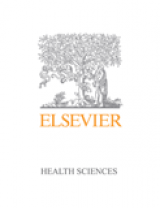This innovative new manual demonstrates the application of vibration technology to the treatment of pathologies such as osteoporosis, osteopenia, stroke and different musculoskeletal disorders. It covers pathology on the upper and lower extremities as well as the whole spine. New treatment strategies are practically and logically presented with recommended exercises and accompanying instructions that can be applied using the vibration platforms. Rationale is given for selected vibration frequencies, amplitudes and modes for the duration and frequency of the exercise session. The manual is grounded in evidence underpinned by a thorough literature review (including a balanced view of both pros and cons) and clinical cases. The authors present clinical treatment parameters that are evidence-based and have supportive physiological rationale that is consistent with the nature of the pathology being treated.
Key Features
- First book of its kind applying evidence-based vibration technology to physical (physiotherapy) and sport therapy practice
- Exercise recommendations accompanied by over 70 four-colour illustrations
- Indications and contra-indications in clinical practice
- Comprehensive literature review of evidence base and principles
- Written and supported by experts actively applying this technology to their practice
Author Information
By Alfio Albasini, PT, GradDip Manip Therap, Private Practicioner; International Teacher, McConnell Institute, Neurodynamic Solutions (NDS); Member of CEC Otto Bock; Member of SUPSI and USI; Università della Svizzera Italiana; Chairman Congresso di Roma, Spine II (2009); Martin Krause, Bachelor Applied Science (Physiotherapy). Graduate Certificate Health Science Education. Master of Applied Science (Manipulative Physiotherapy). Graduate Diploma Health Science (Exercise & Sport). Certificate IV Workplace Assessment and Training, Private Practitioner, Sydney, Australia.; Ingo Volker Rembitzki, PT, Instr. WBV Therapie, Projectmanagement Medical Affairs, Physical therapist, Certified MT and MLT, Chairman of the Clinical Excellence Circle of Otto Bock Health Care Company, Projectmanager Medical Affairs and Instructor WBV therapy.
Foreword by Professor Martha R. HinmanAcknowledgements
Chapter 1 IntroductionHistoryIs vibration a natural stimulus?DefinitionCommercial devices that deliver WBV
Chapter 2 Biomechanic principles of WBVThe inverted pendulum and walkingSimple harmonic motion (SHM)Motor control: length, stiffness and potentialStiffnessResonanceForce exerted by stretched or compressed materialElastic potential energy Hill model of viscoelasticity and motor controlGeneration of torque and the conservation of momentumInverse dynamicsEccentric exercise and plyometricsTensegrityConclusion
Chapter 3 Theoretical considerations in the clinical application of WBV to sarcopenia, osteoporosis and metabolic syndromeSarcopeniaWBV and muscle functionImmune function and SarcopeniaBoneClinical affects of WBV on bone densityClinical affects of WBV on obesity and metabolic syndromeConclusion
Chapter 4 Indications and contraindications in the clinical application of WBV: immediate and long term affects and their influence on the selection of dosageIndicationsContraindicatorsClinical research on acute and long-term effects of WBVThe influence of WBV on painConclusion
Chapter 5 Whole body vibration: treatment with patients or athletesPreparation for TherapyGuidelines and indications using examples of exercises for specific clinical conditionsExercise proposalsStrengthening exercises
Chapter 6 WBV as a warm-up prior to sport - effects on flexibilityWhole body vibration and the effect on flexibility: a reviewConclusionExercises proposals: stretching sectionAppendix: Synopsis of research into WBV Index
"Over the past 5–10 years, I have received hundreds of phone calls and e-mails from individuals worldwide who are seeking health care advice on the benefits of WBV for conditions ranging from motor weaknesses to osteoporosis to autism. Unfortunately most health care professionals, like myself, are faced with more questions than answers when it comes to WBV exercise. Thus, these authors have helped to fill this information void by providing the first in-depth analysis and synthesis of the growing body of research on whole body vibration. They have coupled the results of numerous published studies with their own vast experience to provide an overview of the biomechanical and physiological effects of whole body vibration, as well as training guidelines to address a variety of physical impairments and functional goals. Whether your professional background is in sport science or rehabilitation, you will find evidence-based treatment parameters for improving muscle strength and power, soft tissue flexibility, balance and postural stability, bone density, peripheral circulation, and more. In chapters 5 and 6, the authors have also provided an illustrated, stepwise guide to help the novice practitioner utilize this new exercise modality in a safe and effective manner. These authors, and the researchers whose work they have drawn from, have given us an excellent start. Like any initial work, this text is not necessarily an exhaustive review on the subject, but it does provide the scientific basis, clinical rationale, and treatment parameters needed to incorporate WBV into a physical therapy treatment plan or athletic training regimen with a reasonable assurance of success. And, hopefully, the outcomes experienced by these patients and athletes will be documented and added to the burgeoning body of knowledge that is needed for WBV to gain universal acceptance as a standard part of our clinical practice."
Martha R. Hinman, PT, EdD, Professor, Dept. of Physical TherapyDirector, Transitional DPT ProgramHardin-Simmons UniversityAbilene, TX 79698-6065, USA325-670-5828




